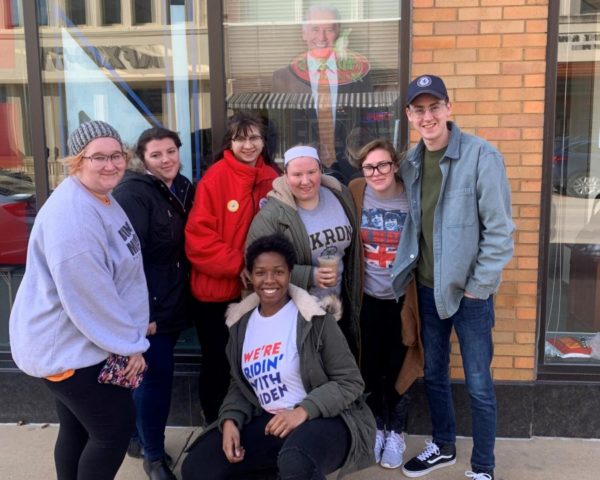Elections commission stalls on pandemic election plan
Wisconsin Elections commissioners stalled on most of a controversial plan that would, among other things, send absentee ballot request forms to most registered voters who haven’t already requested a ballot for the November election.
Instead, commissioners will wait until after Memorial Day to determine what the bulk of a plan to deal with elections in the COVID-19 era should look like, and how to spend some of the $7.3 million in federal COVID-19 funding given to the commission to address challenges to the August and November elections.
Staff at the state agency had proposed using $5.3 million of the funding to not only send a mass mailing of absentee ballot request forms and information about voting options to 2.7 million Wisconsinites, but also to offset mailing expenses incurred by local clerks; redesign absentee ballot envelopes; and provide funding to secure sanitation supplies for upcoming elections.
During a teleconference meeting, commissioners did unanimously approve the portion of the plan allocating $500,000 to local clerks to secure sanitation supplies, such as hand sanitizer, for upcoming elections.
But the commissioners — three Republicans and three Democrats — deadlocked on the rest of the plan. The Republicans on the commission called for scaling back the absentee ballot request form proposal and doing away with some of the formulas to allocate the money, opting instead to send local clerks $3.4 million and giving them the discretion of how to spend it. The proposal would have left the remainder of the $7.3 million to be allocated later.
Democrats, who were in favor of most parts of the $5.3 million proposed plan, rejected the Republican proposal for now, saying they needed to see a more comprehensive picture of what the final Republican proposal would look like.
The commission may still end up approving a more targeted absentee ballot request form proposal that could possibly send forms to millions of registered voters.
Commission chairman Dean Knudson, a Republican, said he would be open to a plan that would send an absentee ballot request form to all registered voters except for those with an absentee ballot request on file, those still suspected of having moved, those who live in cities and towns that already have plans to send an absentee ballot request form, and the 1 million voters who already have a voter ID on file with the state.
Democrats expressed skepticism with some parts of that proposal, but indicated they may be able to work with much of it.
Commissioner Ann Jacobs, a Democrat, said she had major concerns with the commission’s proposal to redesign the absentee ballot envelopes, saying that there’s not enough time and doing so could introduce new errors.
The original plan from commission staff would have spent the money on a grant to offset mailing expenses incurred by local clerks due to increased absentee ballots, costing $2.6 million; a program to send an absentee ballot request form to registered voters who haven’t requested one for November, costing $2.1 million; a redesigned absentee ballot envelope to prevent mailings problems and increase usability, costing $133,320; and a program to fund cleaning and sanitation supplies needed for this year’s elections, costing $500,000, which commissioners approved on Tuesday.
The plan would use funds from The Coronavirus Aid, Relief, and Economic Security Act that Congress passed in March.
The plan to send an absentee ballot request form to most registered voters in the state in order to inform them about their voting options sparked the most controversy.
It’s also similar to plans proposed in cities such as Milwaukee.
The mailing would include an explanation of how to request an absentee ballot through MyVote Wisconsin, the state’s online voter registration system, a paper absentee ballot request form as an alternative option, and a business reply return envelope pre-addressed to the Wisconsin Election Commission.
In addition to sending voters a request form, the plan would also somewhat centralize the process for processing requests. The commission proposed hiring additional temporary staff or working with a data warehouse to receive the mailed forms and enter them into the online MyVote system, as well as scan in photo ID and other application materials. The goal is to alleviate the strain on local clerks who may again face unprecedented absentee ballot requests.
Clerks would still be responsible for ultimately approving the request. The process would also allow Elections Commission temporary staff to notify voters if the photo ID they submitted in their request was rejected in order to free up clerks’ time.
Before the vote, Senate Majority Leader Scott Fitzgerald, R-Juneau, urged commissioners to reject the absentee ballot request form proposal, citing concerns with centralizing absentee voting in Madison. He said such funding should instead go toward local clerks to help them hire extra staff and expand hours for early in-person absentee voting.
He also cited concerns with sending ballots to a voter list “that we know has not been cleaned up,” referring to the fact that thousands of voters who may have moved remain on the state’s rolls as the issue makes its way through state court.
The commission, however, proposed leaving out from the mailing those voters suspected of moving who haven’t registered at a new address or confirmed that they never moved.
Elections challenges
Elections officials are anticipating numerous challenges for the August and November elections following the April 7 election that provided a test-run of how to conduct an election in a pandemic. In that election, Wisconsinites requested absentee ballots in record numbers to avoid showing up at the polls and risking their health. State officials estimate as many as 1.8 million Wisconsinites could request an absentee ballot ahead of the November election.
Besides that unprecedented potential demand, state elections officials want to stem other potential problems faced in April, such as trouble with mailing ballots, inefficient ballot processing, voter confusion, and the high costs of mailing more absentee ballots and providing proper sanitation for voters at the polls.
But despite record-setting absentee voting in April’s election, prompting concerns clerks would be overburdened and some votes left uncounted, a recent Elections Commission report showed the percentage of rejected or returned ballots in the April vote was consistent with previous elections.
Of the more than 1.3 million absentee ballots sent to voters ahead of the April 7 primary, nearly 89% were returned and counted.
The election wasn’t run perfectly, however. The commission determined that 2,693 absentee ballots never were sent to Milwaukee voters due to a technical glitch when Milwaukee elections officials implemented improvements to their computers.
In a situation likely connected with mailing problems, three tubs of 1,600 ballots each for the Appleton/Oshkosh area were never counted, and the elections commission hasn’t determined why because they haven’t received any more information from the U.S. Postal Service.
Smaller cities also reported issues with absentee ballots reaching residents or being returned to elections officials. To improve the mailing process, the commission is looking into implementing a bar-code tracking system that would allow the ballot be tracked by the mailer or the voter.
Other elections data
A federal judge’s six-day extension of the deadline to file an absentee ballot — issued in response to a lawsuit seeking to postpone the vote amid concerns that in-person voting during the COVID-19 pandemic could threaten voters’ safety — resulted in an additional 79,000 ballots being counted, about 7% of the total absentee ballots returned. It’s unlikely such an extension would be granted for future elections.
Absentee ballots and early voting accounted for more than 70% of all votes cast in the presidential primary and spring election.
All told, more than 120,000 absentee ballots were requested but not returned and the remaining roughly 23,000, or about 1.8% of all absentee ballots, were returned and rejected.
For comparison, about 1.5% of absentee ballots were rejected in the 2019 spring election, while spring votes in Wisconsin netted rejection rates between 2% and 2.5% from 2016 through 2018, according to WEC.
While the percentage of rejected ballots was comparable to previous elections, the overall number was considerably higher in the April 7 vote. Just fewer than 2,500 ballots were returned and rejected in the 2019 spring election, compared with more than 20,000 in last month’s vote.












